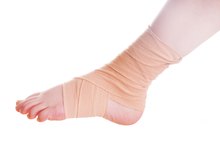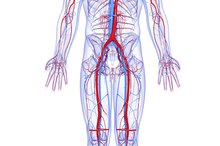What Are the Causes of Unilateral Upper Limb Edema?
Unilateral upper limb edema refers to the swelling of the soft tissues of either the right or left arm or hand. Edema is more common in the legs and feet. If it occurs in the upper extremity, it is usually due to problems with drainage of the blood or lymph from the arm.
If you are experiencing serious medical symptoms, seek emergency treatment immediately.
Deep Vein Thrombosis
A deep vein thrombosis is a blood clot in one of the deep veins of the arms. They are more common when the limb is immobile for long periods of time. Some inherited blood disorders that predispose a person to clotting and some other diseases such as cancer. The blood clot impedes the return of blood to the heart from the arm, and fluid leaks out of the blood vessels into the tissues.
- A deep vein thrombosis is a blood clot in one of the deep veins of the arms.
- The blood clot impedes the return of blood to the heart from the arm, and fluid leaks out of the blood vessels into the tissues.
SVC Syndrome
What Causes Edema in One Ankle?
Learn More
SVC syndrome is the abbreviation for superior vena cava syndrome. The superior vena cava is the vein that drains blood from the upper body back to the heart. In SVC syndrome, the vein is narrowed. The typical culprit is cancer. For example, the right lung abuts the superior vena cava. Lung cancer growing near the vein can compress it, causing blood to back up into the arm. In addition, the slow flowing blood can can cause blood to clot in an arm.
- SVC syndrome is the abbreviation for superior vena cava syndrome.
- In addition, the slow flowing blood can can cause blood to clot in an arm.
Lymphatic Obstruction
The lymphatic system drains fluid from the tissues and returns it to the venous system. **Any disorder that interferes with the drainage of lymphatic fluid from the arm will cause unilateral upper extremity edema 2. In breast cancer, the lymph nodes of the arm and chest wall may be removed during surgery to look for the spread of cancer. Radiation therapy can also damage the lymph nodes. Cancer cells can spread to the lymphatics and interfere with the flow of lymphatic fluid. Infections, typically with parasites, can do the same.
- The lymphatic system drains fluid from the tissues and returns it to the venous system.
- In breast cancer, the lymph nodes of the arm and chest wall may be removed during surgery to look for the spread of cancer.
Reflex Symphathetic Dystrophy
Side Effects of Saline Drip After Surgery
Learn More
Reflex sympathetic dystrophy is also known as complex regional pain syndrome. It is a rare disorder characterized by dysfunction of the nerves and blood vessels in the affected area. It can cause intense burning pain and sensitivity. It often occurs after trauma. In addition to pain, the affected limb may change color, swell with fluid and have limited motion.
- Reflex sympathetic dystrophy is also known as complex regional pain syndrome.
- In addition to pain, the affected limb may change color, swell with fluid and have limited motion.
Related Articles
References
- "Harrison's Principles of Internal Medicine"; Anthony S. Fauci; 17th Ed 2008
- "Pediatric Emergency Care"; Two cases of upper-extremity swelling: Paget-Schroetter syndrome and non-Hodgkin lymphoma.; Dhillon and Spahr; April 2010
- Drews RE, Rabkin DM. Malignancy-related superior vena cava syndrome. Updated June 27, 2019.
- Seligson M. Superior vena cava syndrome. StatPearls. Updated February 4, 2019.
- American Society of Clinical Oncologists. Superior vena cava syndrome. Updated July 2018.
- National Cancer Institute. Cardiopulmonary syndromes (PDQ)–health professional version. Updated June 25, 2019.
Writer Bio
Dr. Matthew Fox graduated from the University of California with a Bachelor of Arts in molecular, cell and developmental biology and received a M.D. from the University of Virginia. He is a pathologist and has experience in internal medicine and cancer research.








